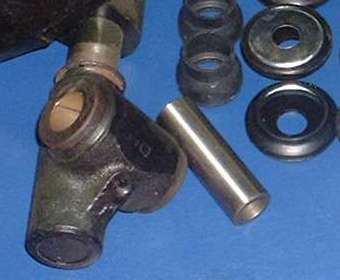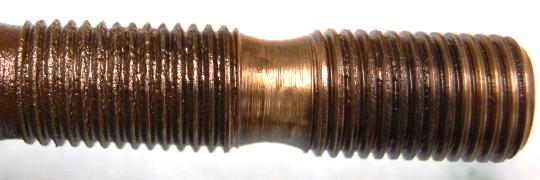The MGA With An Attitude
SWIVEL LINK WEAR - FS-107
At 07:14 PM 10/24/04 -0600, Stan Watkins wrote:
>"My lower trunnions are a bit loose on the swivel pins. The shop manual does not give me much insight into how loose these parts can be. "

These cars were built on the cheap, not necessarily intended to last long enough to be heirlooms. But it was assumed (back in the day) that people would take reasonably good care of their car, and that people would grease them regularly. Then the body and frame might turn to rust before the trunnions wore out. If they never wore out there would be no reason to mention it in the shop manual (wishful thinking?). In fact that is generally the case when greased regularly, but unfortunately lots of them have not been greased often enough over the years, and some are by now in sad condition.
I have had to replace the lower trunnion on the right side when it was worn loose enough to wobble on the thread. That one only made 234,000 miles. The rest are still doing well at 342,000 miles. Threads in the lower swivel links are much more prone to wear than the top ones, as the lower one caries the weight of the car while the top one holds the wheel vertical. Also when the seals fail the lower link is more likely to collect water inside leading to corrosion. The MGA swivel links are cast iron and may wear easily if lubrication or seals fail. The swivel pins are steel and are much less likely to show wear. But if the seals and lubrication fail at the same time and allow water to infiltrate the joint, the male threaded swivel pin can rust and may be badly pitted.

Corrosion causing pitting in the threads - (click for larger image)
There is a significant difference between wear and corrosion in those threads. If the threads were worn out some but still smooth, then keeping it well greased might allow it to run a long time without very much additional wear. The real difference with corrosion is the rough surface on the thread. This could lead to accelerated wear in future normal operation, and no telling when it may get worse to the point of being intolerable. So now it's up to you if you want to pop for new parts.
>"I'm not too keen buying new trunnion$ and $wivel pin$. How loose is too loose?"
Loose is loose, and any wobble is not good. I suggest you keep an eye on eBay, as used parts are considerably cheaper, and will likely last as long as you own the car. A swivel link I bought in 1996 cost $40 used from a local shop (when they were $89 new). If I had more patience I might have found one for less. I have since bought complete swivel pin assemblies with the trunnions for both side for about $100 complete (twice), rebuilt them and sold them for about double the cost of parts and labor. I don't even want to think about the price of new ones, as I would never buy them new.
----------
At 08:30 PM 4/6/06, Dan Suter wrote:
"We've been using the following procedure to check the looseness of the threads in the swivel pin assemblies: Lightly clamp the trunnion in a large vice with the pin fully threaded in as it would be assembled on the car; pin in vertical position; then move it laterally to observe looseness at the threads. It is cleaned of all grease. So far all parts have pretty noticeable movement. .... Is this a good method to check; do you have a descriptive rule of thumb on 'how much is too much?"
That may be a good way of comparison to see which one is better or worse than another, but that's not the way it works in the real world. With long swivel pin and shorter length of thread engagement you will get a relatively large wobble at the free end of the swivel pin. If you have about 10" of total length to the swivel pin, but only 2" of thread engagement, the clearance in the thread will be amplified by about 5 to 1 at the end of the swivel pin. With 1/32" clearance in the thread you would see 5/32" wobble at the end of the pin, which looks like a lot, but may not be as serious as it sounds. You can use this wobble as a point of comparison, but it doesn't tell you much about how bad a wheel might wobble
The motion you should be looking at is the amount of lateral motion at the swivel link bushing if you hold the swivel pin still. On the car the swivel pin is held almost stationary at both ends, and the bottom link may wiggle 1/32" at the trunnion bushing, so the swivel pin motion is much less.
The top and bottom trunnion bolts may be about 8 inches apart. The tire is about 24.6" diameter, or 12.3: radius. Add half the distance between the trunnions, and you have about 16.3" from top trunnion to ground. Compare that to the 8" between trunnions, and you have about 2 to 1 lever ratio. If the bottom swivel link wobbles 1/32" the bottom of the tire may wobble 1/16". So what you may observe as 5/32" wiggle at the top end of a free standing swivel pin may only show as 2/32" lateral motion of the tire at the road. That is similar to a slightly loose wheel bearing, and the ball bearings on the MGA have a small amount of internal clearance to begin with. When driving the car the only way you notice that small motion is if the tire is out of balance and creates a serious enough wobble to shake the front end of the car, which might make the steering wheel chatter a bit.
You can check these joints on the car, the same way you check dual ball joint suspension on newer cars. Place a floor jack under the A-arm, directly under the coil spring. Lift enough to raise the tire off the floor. This unloads all of the suspension joints and wheel bearings, except for the A-arm inner pivot. Then grasp the tire at the bottom and push/pull in and out laterally to see how much it wiggles. If you get up to 1/16" wiggle at the bottom of the tire it is nothing to snivel about. If you have 1/8" or more wobble at the bottom of the tire, it's time to look to see what's wiggling and replace some worn parts.
Several years ago I had one substantially worn lower swivel link where the bottom of the tire would wobble about 1/8" when unloaded, or maybe a little more. Before or after changing the part there was no noticeable difference in the way the car handled, even with autocrossing on sticky race tires. This is not a serious matter of life and limb. It only becomes serious if it allows the front end to chatter with a wheel out of balance, or if it gets so loose that it is in imminent danger of becoming disconnected. It is more likely to become a personal irritant before it gets anywhere close to falling apart.
I don't recall ever seeing a top swivel link noticeably worn, only the bottom ones. If the seals go bad the top one drains while the bottom one catches water. The bottom one is also carrying the weight of the vehicle, while the top on is only holding the tire up straight and taking the dynamic load of the shock absorber (which is not a shock load).
If you want a better idea of how worn the swivel link is, clamp the swivel pin in a vice, put a bar through the trunnion bushing, push/pull and see how far the bar may move laterally. Ideally of course the motion of new parts would be virtually zero when the threads are coated with grease. But I would make allowances for a 45 to 50 year old car to be somewhat less new. If you can, look for used lower trunnions with minimal wobble. If you were doing a complete restoration or building a daily driver that you expect to run far enough to wear out a couple more engines, then you would want very good parts there. If it will be a trailer queen show car or an occasional driver expected to run 2000 miles per year, a moderately worn swivel link could well last another 25 years or more when properly greased.
When I bought my MGA in 1977 it was 20 years old with 150,000 miles, used and abused, pranged and bondoed over and repainted twice, pretty well clapped out and generally used up, but not excessively rusty. I suspect the lube jobs had been somewhat neglected over the years similar to the rest of the car. I restored it put another 130,000 miles on it, gave it another repaint and fabrics, and put another 70,000 miles on it. Today going on its 4th engine, 5th paint job, 3rd interior, and several gearbox rebuilds, it now has 350,000 miles, and 3 of the 4 swivel links are still original and serviceable.
If you can find used trunnions which are half as worn as the ones you are removing, and you keep them well greased, you may expect them to run at least half as far as the original mileage on the car (and probably farther) before being that worn again. Keep looking at used ones. There must still be some decent ones out there, as the parts cars can't all be over 200,000 miles. I wouldn't put new parts on my car at that price. One of the best benefits of being intimate with the car is being able to figure out which parts you can continue to use.
|